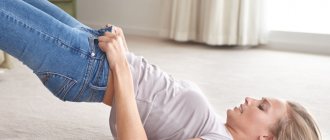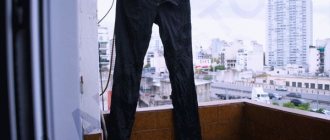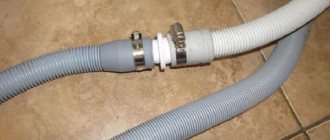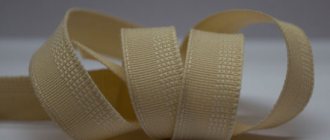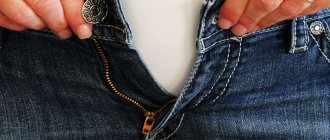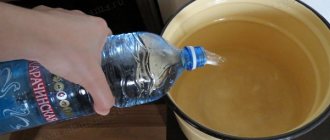Classic pants
Classic models - men's, women's or children's - are lengthened using similar techniques.
The simplest method is when the depth of the hem allows you to add length without the use of other materials. If you need to lengthen the trousers by 1-2 cm, you can open the seam along the bottom edge, iron it, and mark a new hem line.
In men's models, a lapel is often found. This also simplifies the task. Before lengthening, you must carefully - using a seam ripper, a knife or nail scissors - rip the bottom seam and the seams of the trouser tape (if any). It protects the bottom of the product from abrasion. If there is no trouser tape, it is advisable to sew it on.
The thickened edge of the braid should be at the bottom. For grinding you need:
- mark a line on the wrong side of the fabric;
- measure the width of the braid and place it above the hem line;
- Sew a seam along the top edge to secure the trouser tape;
- iron the lower parts of the trouser legs so that only the thickened roll is visible from under the hem;
- Hem the trousers using a machine or with a blind seam by hand.
The color of the trouser tape must exactly match the shade of the fabric.
Algorithm for lengthening trousers:
- 1. Carefully open the hem seam. Remove the tape.
- 2. Using a sewing needle, remove any remaining thread.
- 3. Iron open seam lines.
- 4. Measure the width of the trouser legs (it will be different in the front and back).
- 5. Use scraps of fabric to create a pattern for the hem pieces. Mark the width (separately for the back and front halves) and length (for the inner hem 2.5-3 cm). Take seam allowances into account.
- 6. Cut out the details.
- 7. Stitch the side parts of the parts. Press the seams.
- 8. Sew the parts to the product using a basting stitch.
- 9. Machine stitch the intended seam. If you don't have a sewing machine, you can use a hand-stitched backstitch.
- 10. Iron the seam through an ironing iron (gauze).
- 11. Mark a line for sewing the trouser tape and stitch it.
- 12. Hem the trousers using a basting stitch or tailor's pins.
- 13. Iron the hem.
- 14. Along the top hem line, sew a machine stitch in increments of at least 2.5 mm or a hand-blind stitch.
- 15. Iron the hem.
If you have scraps of the same fabric from which the product is made, you can make an addition in the form of a lapel. It can be simple or double. To cut out a part, the height of the lapel is added to the hem size (from 3 to 5 cm in finished form on classic models).
To lengthen using a lapel you need:
- on both sides of the trouser legs, open the side seam by 1-2 cm;
- Sew cuff details to the bottom edges of the trousers;
- iron the seams;
- fold the free edge of the parts inward and stitch to the trouser legs;
- iron the cuffs and sew the side seams;
- It is advisable to strengthen the details of the cuffs on the wrong side with an adhesive pad.
Each operation must be accompanied by ironing, only in this case the result will be impeccable. All details are cut out using a shared thread !
Exceptions are models cut on the bias.
How to add length to jeans
Is it possible to dye trousers at home?
Before starting the process, you should take measurements. First, take a measurement called “pants length along the side seam.” You need to measure the length of the item from the waist down. If long pants will be worn with high-heeled shoes, you should wear them during measurements. The jeans can be any length after alteration. The maximum is the following:
- Classic men's trousers require a pleat in the front. It is necessary so that your socks are not noticeable while walking. At the back, the bottom of the pants should be located between the center of the heel and the top edge of the sole;
- For modern European trousers for men, you should choose a length shorter than the classic options by no more than 2 cm;
- Classic women's products should be the length of the center of the heel;
- The length of children's clothes depends on the specific case and preferences. Clothing for a child should be comfortable. It is considered optimal when the trousers cover the ankle.
You should measure the length of the item along the side seam and compare it with the measurement taken. The main calculated characteristic below will be the difference between them. It is also worth measuring the width of the trouser legs, taking into account seam allowances. Along the bottom edge they will be 3 cm, along the side seam and stitching line - 1.5 cm. For lace and braid, allowances along the bottom edge are not needed.
This method is suitable for old favorite items that you don’t want to say goodbye to. At the bottom, the jeans have lost their former appeal, but that's no reason to throw them away.
How to sew a cuff to jeans
Let's look at some interesting ideas on how to lengthen children's jeans by 5 cm or more:
Open the hem seam at the bottom of the trouser leg, fold the cut to the minimum allowable length, add lace for women's or children's products, or sew a cuff from another fabric of a suitable color; Release the seam from the bottom of the trouser leg, hem it with tape
It is important to lay a finishing stitch on top, choosing threads with the appropriate shade; Cut off part of the trouser leg, make an insert from another material... Sometimes the item shrinks after washing. Then you need to follow this algorithm:
Then you need to follow this algorithm:
Sometimes the item shrinks after washing. Then you need to follow this algorithm:
- Flog the finishing line from the bottom of the pants, remove the protruding threads;
- Process the cut. For this purpose, use an overlock stitch on a machine.
Important: When lengthening skinny jeans, you should place the lace on the overlock seam and sew a fixing stitch in a circle. The design technique with lace is used for women's products. When choosing high-quality decorative tape, the item will look stylish
You can use the method for products for little girls who have outgrown jeans but don’t want to part with them.
When choosing high-quality decorative tape, the item will look stylish. You can use the method for products for little girls who have outgrown jeans but don’t want to part with them.
The design technique with lace is used for women's products. When choosing high-quality decorative tape, the item will look stylish. You can use the method for products for little girls who have outgrown jeans but don't want to part with them.
Interesting ideas for decorating jeans that will add a few centimeters in length
For the third method, you will need a snipper, a utility knife or nail scissors.
Carefully unpick the finishing stitch at the bottom of the trouser leg; Unfold the edge, process the folds with a steam iron; Measure the required length and draw a line with soap. The markings will show the new edge of the trouser leg; Decide on the method of processing the bottom
When using trouser tape, you do not need to use an overlocker for cuts.
On the cut at the top of the fabric, attach the braid with an edging to the trouser leg. It is important that the gap from the braid to the edge of the trouser leg is approximately 0.5 cm. Then sew a stitch; Fold the tape to the wrong side, make a finishing stitch along the bottom of the trouser leg
When lengthening your child’s jeans, do not overdo it with decor - use no more than three elements
To lengthen the low waist of old but favorite flared jeans, you need to do it yourself:
Choose fabric for the belt; Undo the belt loops and carefully remove the button; Sew the new belt to the middle of the old one so that the loop is above the sewing line; Fold the belt so that the inner cut is under the top line of the old belt; Mark the inflection line; Process the sections of the new belt, sew up the darts, lay a strip of denim material along the fold line to increase the density; Sew on the old harnesses, process the loops and button. Thus, the low rise was transformed into a fashionable high rise.
What should be the length of jeans
It is not always good to increase the length to the point you need, since this most likely will not coincide with modern standards of beauty, and denim trousers will become pretentious and ugly.
It is necessary to maintain standards in order to increase jeans to the length that you like and will correspond to current fashion standards.
Women's jeans length:
- Classic cut. Versatile trousers suitable for many tasks. They also look good on a person, regardless of his height and build. Characteristic features are straight lines, sometimes the jeans are tapered at the bottom. By modern fashion standards, jeans should cover half the heel of the shoe.
- Flare. The length of the trousers is selected to match the woman’s shoes. If a girl wears heels most of the time, then the length of such jeans should completely cover it. In the case of flat shoes, the trouser leg should reach the floor.
- Skinny skinny jeans. Should completely cover the heel or reach the ankle.
Men are no exception and they also need to choose the right length of jeans. Poorly chosen trousers reveal a person's taste. Too long ones give a sloppy appearance, and too short ones create the image of a boy, killing his seriousness in a man.
Classic jeans should lightly cover a man's shoes and not touch the floor. There should be a distance of about 2 cm from the edge of the jeans to the sole.
Skinny jeans should not fit over your shoes. Where the shoes begin, the pants end.
Lengthening trousers at home
How to untangle a gold chain at home. how to untangle a chain at home. lubricate the chain with oil and soap
In order to lengthen your pants at home, it is not necessary to have the same material. Other fabrics that work well include colored patches, lace or tape for trousers, and knit cuffs for sweatpants.
Other materials you may need:
- sewing machine;
- threads;
- needle;
- scissors;
- piece of fabric.
Another important point in preparing for work is measuring the width of the trouser leg and calculating the material for hemming with allowance for seams and overlock. You need to leave at least 1.5 centimeters on the sides, and at least 3 centimeters on the bottom.
How to lengthen classic trousers (men's, women's) when there is no stock
Sometimes it happens that excellent dress pants fit perfectly on the hips and waist, but they have become short and there is no reserve of fabric that can be used at the bottom of the leg. In this case, you can use trouser braid or a piece of the same fabric. Below we will look in more detail at exactly how to use these 2 features.
Women's and men's dress pants are lengthened using similar techniques. Therefore, these methods are suitable for both options.
With braid
The braid should be selected in such a way that it matches the color. To begin work, be sure to open the seams of the fabric hem and remove the threads. Then be sure to steam and smooth the fold seams well.
In order to cut out the fabric on the part, you need to separately measure the width of both parts of the leg and the required length of the material. Be sure to take into account that there should be at least 3 centimeters left on the inside hem, and also add seam allowances. Then sew the cut pieces together and carefully press the seams. After this, baste the extensions to the trouser leg and try it on to make sure it is of sufficient length.
The next step is to sew the seam on a sewing machine and iron it through gauze. Then baste the trouser tape and stitch it, and then sew the hem for the trouser leg and iron it again.
With lapels
An excellent option for increasing the length would be a lapel made of the same material. This addition will look very neat when finished. You need to cut out the details for the hem taking into account the height of the lapel - from 3 centimeters.
The process of performing an extension with a lapel:
- Open the legs and about 2 centimeters of the side seam.
- Sew the cuff pieces to the bottom edge of the trousers.
- Iron the seams.
- Sew the side seams of the trousers.
- Treat the cuffs on the wrong side with adhesive tape and secure along the seams (if the product is made of stretch fabric, then there is no need to glue the tape).
Ideas for lengthening women's trousers
You can also lengthen women's pants quite easily. Because by using your imagination you can not only decorate your jeans, but also give them a unique style and personality. Nowadays, interesting solutions with lace or play of colors and textures of materials are very popular in fashion.
You can lengthen them using allowances, cuffs, lace or other textured fabrics that will brightly complement the look. However, it should be borne in mind that it is better not to use too bright elements if you plan to wear trousers to the office and to work. These options are better suited for everyday casual style.
cuffs
An interesting way to lengthen it is to sew the cuffs to the bottom of the legs. In this option, it is not necessary to use a material with a similar texture (for example, denim) and you can take a fabric of a different color. Pants with wide cuffs will look quite elegant, and you can complement them with a fake button fastening along the side seam.
Let's take a closer look at the stages of creating cuffs to lengthen trousers:
- Select the material and cut out two rectangles of future cuffs from it, the width of which corresponds to the width of the trouser leg, and the length required with seam allowances.
- Sew the pieces of fabric on a sewing machine and iron the seams.
- Sew the side seams and finish the hems at the bottom.
To ensure that no one guesses about lengthening your trousers yourself, you can treat the pockets on your trousers with the same material. This decision will be very interesting, and jeans will continue to be in fashion.
Knitted border
Another interesting way to lengthen your pants is to sew a knitted border or lace onto them. Needlewomen can knit such a border themselves or buy it in a specialized store. Fortunately, there is quite a large selection of different materials.
According to your taste, you can sew the border so that it extends the length of the product, and also so that it extends slightly onto the main trouser fabric. This solution will be very original, and the trousers will become more feminine.
In order to sew such a border to the trousers, you need to measure the required amount of material along the width of the trouser leg with an allowance for the side seams. Sew the knitted border along the bottom line of the trousers. Then baste and stitch the side seams on a sewing machine, and then smooth them out with an iron.
Simple ways
Think ahead about how you want to present your fitted and updated jeans. What will it be, a classic version of the product or an extravagant model. How the extension will be carried out depends on this. There are several ways: by changing the position of the seam, adding an insert or cuffs, or using a seamless method.
Changing a Hem Seam
The easiest way to lengthen jeans is to change the factory hem seam. This procedure can be done independently at home. To do this you will need scissors, chalk or pencil, thread and a needle. It is recommended to do the stitching on a sewing machine, this will make it smoother and less noticeable. But, if there is no such equipment, then you can stitch the product using a thin needle.
- Turn the garment inside out.
- Find the factory seam on them and open it using scissors or a sharp knife. This must be done extremely carefully so as not to damage the material.
- Remove the threads from both sides of the product and straighten it in the place where the seam was.
- Iron each leg of the jeans thoroughly. It is better to use an iron with a steam function for this purpose, this will help mask the seam more effectively.
- Try the jeans on yourself and mark the new length. This can be done with chalk or a simple pencil.
- Make a seam according to the new marking by folding the edge of the trouser leg or sewing it onto a special trouser tape.
After finishing the job, iron the jeans again and try them on yourself. The advantage of this method is simplicity. In addition, if you were unable to achieve the desired length the first time, you can carefully remove the seam and reposition it.
Important!
If you use braid for hemming, do not sew it to the very bottom of the pant leg. There should be 5 - 5.5 mm left from the hem or cut line to it.
Insert from another material
You can lengthen your favorite denim trousers by inserting them from another material, but you need to keep in mind that this is a very painstaking, creative work that will take a lot of time. Prepare the material. You can use denim, plain or colored thin fabric. Women's legs will be decorated with lace inserts or dense mesh. The extension algorithm is simple:
- Turn the product inside out and open the side seam to the place where the insert will be. It makes more sense to make it below the knee, since in this area the fabric practically does not stretch when worn.
- Carefully cut the pant leg.
- Prepare the material for insertion. The width should match the trouser leg, and the length should be equal to the distance by which the clothing needs to be lengthened.
- Sew the insert to the top and bottom of the pant leg.
- Bring the side seam back together.
Carefully iron the finished product from the wrong side or right side. If you don't have a steam iron, iron through damp gauze. Do the same procedure with the second leg. The advantage is that the material can be changed periodically, giving the jeans a new look.
Use water
A master class on lengthening denim trousers can be held at home. This does not require a sewing machine, needle, thread, or even scissors. It is enough to have water and any soap product in the house, for example, baby shampoo or liquid soap. The easy lengthening process consists of several steps:
- Fill the bathtub with warm water. Add one capful of shampoo or liquid soap to it to make a weak soapy solution.
- Place clean jeans in it and leave to soak for 30-50 minutes.
- Carefully remove the clothes and wait for the water to drain from them.
- Wrap it in a terry towel so that a tight roll is formed. Make pressing movements until it absorbs moisture. Change the towel until it remains dry after intense pressure.
- Place the wet jeans on a sheet and pull each leg up from the bottom until it reaches its maximum possible length.
Tips for lengthening jeans at home
What to wear with blue women's trousers?
Lengthening jeans is a complex, sensitive process. The slightest violation will lead to damage to the product and the impossibility of restoring its appearance.
To avoid mistakes, before you get to work, pay attention to the basic recommendations for lengthening jeans at home:
- pre-wash and dry clothes;
- for inserts, choose thin material, it is easier to sew to the trouser leg;
- You can stretch wet jeans if there are no decorated holes or rhinestones;
- carefully sew on the material for the inserts, it should not pull the trouser leg.
The main rule is to take your time. Take responsibility for each stage of work. Only in this case the result will meet your expectations.
Common mistakes
During the process of lengthening jeans, there may be some difficulties that everyone who wants to do this business faces.
Before you begin, you are encouraged to familiarize yourself with the following recommendations:
- Be sure to wash and iron your jeans thoroughly before lengthening them;
- If you need to embroider the factory hem followed by soaking, then iron the trousers until the fold line disappears;
- Never skip basting elements to lengthen jeans, otherwise wrinkles will begin to form at the junction of the trouser fabric;
- The material of the jeans and the color of the threads used must match;
- If the sewing equipment does not have enough power to stitch the fabric, then you will have to do the extension manually;
It is recommended to try on jeans before lengthening to know the required sizes.
Patience and endurance will allow you to enjoy your new long-length jeans, which will add a bit of style and glamor to your style.
Ways to lengthen men's and women's jeans, how to do it yourself
The choice of how to lengthen jeans depends on the condition of the product, purpose, age, gender of the owner, taste and preferences. The technology for doing the work is different, but if you have certain skills it can easily be done at home.
Soaking
The method is used when you need to return to the previous length after shrinkage.
A soap solution helps to draw out the material:
- Jeans are soaked in a spacious container in warm water with soap or baby shampoo for about 30 minutes.
- Let it drain without squeezing.
- The remaining water is squeezed out by rolling up a roller with a dry terry towel.
- Place wet jeans on a dry sheet or towel.
- Using movements from the waist down, the legs are pulled out alternately.
- For final drying, the trousers are hung in a vertical position.
With finishing
You can lengthen children's jeans for girls with lace, decorative braid, and fringe.
In this case, the hem and side seam are not ripped out, but the trim is sewn to the wrong side with the top edge using a zig-zag stitch or by hand. This method is not suitable for rough finishes.
How to pack a suitcase without wrinkles: packing a dress, skirt, suit, shoes
The lower part of the jeans is most often decorated with a hem seam, which, by unrolling, can give you an additional length of 3 to 4 cm:
- The finishing seam is carefully steamed using scissors or a blade, and the remaining threads are removed.
- Fold lines are smoothed using a damp cloth or a steaming iron.
- Two strips of denim fabric equal to the width of the trouser legs are cut out with a seam allowance.
- The parts are placed right sides together and sewn along the bottom of the product.
- The sewn stripes are the new hem. It is ironed, decorated with a new finishing stitch of the desired color, or basted by hand from the wrong side.
Fabrics of similar color and texture or, conversely, contrasting inserts are used to increase the length in the lower part of the trousers, creating cuffs or lapels:
- Measure the width of the cuff along the bottom edge of the trouser leg, place it on the selected fabric, and add 2.5 cm for stitching.
- Measure the desired cuff height with seam allowance and cut out two rectangles.
- The side seam of the cuff is sewn and processed.
- Rip out the bottom seam of the trouser leg and carefully smooth out the fold lines.
- The top of the cuff and the bottom of the product are connected with pins or a basting seam, after fitting they are sewn on, reinforcing the cuffs with non-woven fabric.
- The details are ironed and a lapel is made.
The reverse part is decorated with fabric of the same size, which has a thin and soft structure. If the belt is not double and you cannot increase the length with it, you can make an insert between the top of the trousers and the belt.
To do this, carefully rip off the belt, sew the insert to the edge of the product, carefully iron it and sew the belt into place.
If the height of the belt is not enough to lengthen, cut out a new belt from denim fabric of the required size. Its sections are processed, an inflection line is marked, and sewn to the product.
Beautifully lengthen a short dress or skirt with your own hands - great ideas
They use both old harnesses and new elements, loops, buttons. This way you can lengthen low-rise pants.
Classic products require the use of more restrained lengthening techniques.
It is necessary to make maximum use of the depth of the bottom hem without using other material, the height of the lapel:
- The bottom seam is ripped out, carefully ironed and a new fold is made to a shallower depth. In this way you can lengthen the product by 1-2 cm.
- If the depth of the bottom hem is insignificant, a trouser tape that is sewn to the bottom edge of the trouser leg will help to add 1-2 cm. It will act as a hem.
- Trousers with a lapel can be lengthened by reducing the height of the lapel, or removed by moving the fold line to the desired size.
- If you have leftover fabric from sewing the same product, you can lengthen the trousers by adding a simple or double lapel, which will hide the seaming line of the parts.
These methods are used for both male and female models. You can also lengthen women's trousers at home using decorative elements: lace, braid, thin fabrics to match the product.
We suggest you read How to decorate a leather jacket at home
Edge Length Adjustment
The method will lengthen the jeans by using hem fabric. This way it is possible to make the trouser legs longer by a maximum of 2.5 cm. The work is carried out on washed and dried trousers. It is permissible to rip the hem before washing the trousers or after this process. The threads from the seam are carefully removed. The whole process consists of the following steps:
- dampen the bottom of the trousers and iron them so as to make the fold invisible;
- cut out 2 ribbons 4 cm wide along the transverse thread of fabric;
- align the elements with their upper sides, place a long piece of tape on the bottom of the trouser leg, and stitch after basting. Fold back and iron the seam;
- unscrew the sewn tape, as with the usual processing of the bottom of the item. Baste the formed hem and sew it by hand so that the seam is not visible from the outside of the product.
Stripes - the most unusual option
Stripes are stripes of colored cloth that run along the entire length of the pants. Red stripes can often be seen on the trousers of command staff of the Armed Forces. In addition to their decorative function, they can also be used to increase the volume of trouser legs.
They are cut in the form of thin strips along the entire length of the trousers. To decorate trousers, you can use several thin strips, glued directly to the canvas using a special spider net and an iron.
You can not only embroider, but also decorate trousers with stripes
In order to widen the trousers using stripes, you need to rip the side seams up to the waist, and then carefully sew the stripes into the trousers on both sides.
When choosing a material for stripes, it is necessary to take into account not only its quality, but also how the chosen color will look on the finished item. Bright colors go well with black tights: light green, pink, blue, and black stripes will look best on white pants.
From all of the above, we can conclude that the main way to increase the volume of trousers is to insert various pieces of fabric into the problem parts of the trousers. This requires not only knowledge, but also considerable sewing skill. Also, in most cases, you cannot do without a sewing machine and the ability to choose the right material. Therefore, if you are not confident that you will not make a mistake with the size of the inserts or lay an even seam, then it makes sense to contact a studio where qualified specialists will work on the item. Enthusiasts who do not have sufficient skills should first practice sewing inserts on things that are not used for going out.
An elastic band will come to the rescue
Is it possible to increase the size of a product using a web? Can be expanded by the amount of allowance on the sides.
Cobweb is a special material consisting of thin adhesive fibers.
How to glue cobwebs to fabric?
- First, open the seams on both sides of the product and smooth it with an iron.
- Measure out the required amount of web. Add 1cm on both sides for overlap.
- From the inside out, apply the mesh so that the edges of the seams of the product are located close to each other, leaving no gaps.
- Using a heated iron, iron over the paper base, then remove it.
- Place the other side on top to cover the adhesive base by 1–2 mm.
- Iron the surface to ensure good adhesion. You can put gauze on top and iron through the gauze.
If the seam stands out, you can sew on stripes.
Such products must be washed by hand and not often, otherwise the cobwebs will come off.
You can widen your trousers using an elastic band. An elastic band will come to the rescue in all cases when you need to increase the volume at the waist, when the trousers have become too small with a zipper on the side. Let's look at how to increase volume with a side zipper correctly.
- Steam out the zipper and remove the hard belt.
- Sew the side seam where the zipper was to the stitching done with an overlocker. If this volume is not enough, then insert a wedge of the required size and sew it in.
- Sew fabric to the waistband to fit two or three rows of elastic.
- Sew on a new belt, make two or three lines, insert an elastic band.
When everything possible has been ripped apart and placed, but the width of the trousers is not satisfactory, we make an insert into the belt. We increase the volume with an elastic band.
- We rip the side seams to the desired length.
- We remove the zipper in front and also remove the belt.
- We select the front and back insert to the width of the elastic, and sew it with the elastic.
- Baste instead of a belt.
- We sew it on a machine and process the cuts with an overlocker.
- To make the belt look aesthetically pleasing, we add additional stitches along the seams.
Such a transformation is only possible on a thin figure. Fat ladies can do a different manipulation.
Stretch with iron
The iron switches to steam mode. Hot, humid air will warm up the denim threads well. As a result, the wet, hot fabric will expand and stretch. After such a wet ironing, you should immediately put the product on yourself and walk around in it until it dries completely. To consolidate the result, you need to squat intensively so that the threads stretch even better.
If your jeans become too small, it’s not a problem. Denim, the main material for denim pants, has good elasticity and strength, which allows you to stretch them in the waistband right at home without “surgical intervention.” There are two most common ways to stretch pants.
You can increase the size of your pants by soaking and stretching, but the result is questionable
Spraying
To do this, you will need a spray bottle into which you need to pour warm, clean water. After this, wet the belt from the inside and outside until the material is completely saturated with water. Stretch the belt with a few smooth movements. The main thing is not to stretch the material where there are abrasions, otherwise there is a risk of simply tearing the product. After the belt has dried, you can look at the result using a centimeter.
Soak
do squats, stretch, etc. You need to dry the jeans a little while they are on, then dry them in the fresh air so that they retain their body shape. If you use a hair dryer or dryer, the jeans will shrink again and the procedure will be useless. Soaking will help stretch the jeans not only at the waist, but also in other areas that cause discomfort, such as the hips or buttocks.
It is important to remember that both of these methods are only suitable for stretch denim. The material for dress pants may not survive such procedures and may tear.
It is also possible that the jeans will shrink again and return to their original size after several washes. If this happens, then more radical measures cannot be avoided.
Reviews
Svetlana
Five years ago, I unsuccessfully washed my favorite jeans in the machine. After that they sat down and were short. The stretching method was ideal. But, I pulled them out not on the sheet, but on myself. She put on her slightly damp jeans and pulled them down until they became longer. Then I dried it. Fortunately, this helped me get my previous length back.
Victoria
A few years ago, my daughter’s jeans became too small. It was a pity to throw them away, since they were her favorite ones. I decided to lengthen them using fabric inserts. First I took cotton fabric and sewed it on, but it quickly stretched and began to look ugly. Replaced it with denser material. The result was excellent, my daughter wore them until they became too small for her again.
How do you like the article?
How to lengthen men's jeans
It is better to add men's jeans using denim or regular fabric. Choose plaid, striped or plain fabric. It is better to put regular fabric on the bottom.
If you want to make your jeans more interesting, but not provocative, then make a denim insert in the middle of the trousers or just below the pockets.
An insert with many finishing lines, vertical, horizontal, and located diagonally, will look beautiful and quite stern, masculine. You can add more details in the form of a strap, pocket or valve.
An extension made of leather (smooth or suede) in a dark color will look impressive.
How to add a bottom
The easiest way is to take your jeans to a tailor and they will do everything for you in the best possible way. But you can tinker a little, making an original thing and the only one of its kind.
So, you can add the bottom of your jeans using the following fabrics:
- jeans (plain, contrasting or patterned);
- genuine leather;
- cotton, wool, silk or any other fabric, even brocade.
In addition to fabric, you can use:
- twill tape;
- braid, braid with fringe;
- lace;
- sewing (a strip of cotton with an ornament embossed along the edge, in the form of an embroidered pattern or hemstitch);
- accessories (chains, hooks, laces and eyelets).
Let's take a closer look at how you can lengthen jeans with your own hands. First, use a foam (a part for easy ripping) to open the hem of the bottom. Remove the threads and steam with an iron.
Try it on and decide how short your jeans are now. If the length is optimal, hem it. Finish the bottom with a zigzag or overlock stitch and tuck it in one layer by 0.5 cm.
You can not hem the edge, but fluff it up, making a fringe or sew on a factory one.
Think about what style your jeans will look like after restoration: business (as much as possible in jeans), work, stylish or glamorous-eccentric.
To find out how much to add to the bottom, measure the length of the trouser leg along the midline from the top (waistband) to the bottom edge. Then measure yourself or the person you are altering for. For example, we took measurements - the required length of the jeans is 115 cm, and the trousers (with the hem cut) are 111 cm (of which minus 1 cm for the seam), which means that a strip 10 cm high is needed to fold it in half. Plus 2 cm per seam.
In total, we cut a strip 12 cm high and 1 cm wider than the bottom of the trousers. Glue, hide, sew the side seam and sew to the bottom of the trousers. The side seam and the seam along the cuff can be stitched with two lines, like on jeans.
If you want to make a cuff at the bottom of the trousers, then you need to add another height to the required height (multiplied by two, since we make the hem fabric in two layers), to which you will always tuck.
Important! The bottom of the trousers gets dirty and worn out faster, so a beautiful and light fabric for the extension will look impressive, but not for long. A thick denim option would be optimal.
An insert or cuff made of genuine leather will be durable, but easy to care for. Poorly treated leather will bulge or shrink after washing. Jeans with leather inserts should not be dried on a radiator or heater to prevent the leather from becoming deformed.
If you choose an insert made of cotton, wool or other fabric, be sure to glue it with double-lined or non-woven fabric (strengthen it!).
Classic men's trousers are always hemmed at the bottom with twill tape to prevent the edge of the product from rubbing off. You can do the same with jeans, but first open the seam along the hemmed edge. Iron the bottom and sew on the ribbon.
The edge of the jeans does not need to be processed; it will remain inside. The tape needs to be placed on top, stitched, and then tucked inward and stitched along the other edge of the tape or sewn by hand. Finishing stitches can be made if desired.
How to lengthen women's or men's jeans, trousers and sweatpants
For the production of sportswear, elastic, knitted fabrics are usually used, so the best material for lengthening them is knitted elastic.
A cuff is cut out of it, which is sewn to the lower edge of the trouser leg. The cuff will be double, so its height is multiplied by 2 and a seaming allowance of 1.6 cm is added.
Sequencing:
- The cuffs are sewn down along the side seams, turned seam inside out and folded in half.
- Combine the inner seams of the trouser leg and cuff, baste the seam, stretching the elastic evenly.
- Once everything has gone well, the part is sewn on with an overlocker or zig-zag stitch, loosening the top thread.
Various finishing inserts made of contrasting, transparent or color-matching materials will help you lengthen your sweatpants.
The best option is if the fabrics match in stretchability, so that the stitching area looks neat. The inserts are placed under the knee, at knee level or at the bottom of the trouser leg.
Utility denim is widely used in clothing but has the ability to shrink. To lengthen jeans, sweatpants, trousers, various methods are used that are accessible even to non-professionals.
A creative approach to alterations will save you the cost of purchasing new clothes.
Features of lengthening jeans
In order to properly lengthen jeans with your own hands and not spoil the item, you need to take into account the properties of the material and the features of its processing. A small violation will lead to final damage to the item and the inability to restore it later. To get started, you need to prepare all the tools and materials:
- scissors, needles and pins;
- high-quality threads that match the color of the main fabric;
- chalk or soap for marking;
- tape measure;
- extension material.
The following tips will help you successfully transform your favorite item and make your jeans a little longer:
- Before work, trousers must be washed and dried thoroughly;
- thin fabrics are easier to sew onto jeans, so it’s better to choose them for inserts;
- for thick denim, you cannot use material that is too light to lengthen the pants, as the contrast will be too noticeable;
- when sewing the inserts, you must ensure that the material does not tighten the trouser leg;
- the fabric for the inserts must match the material in terms of stretch level, then the updated product will look neat and beautiful;
- You need to start working after trying on the trousers with shoes in order to correctly choose the optimal length.
Important! To lengthen your jeans by about 2 cm, you can use the seamless methods described below.
How to lengthen women's jeans
Women's jeans can be lengthened with lace, openwork or colored cuffs. Elegant inserts will not only transform the thing itself, but also emphasize the beauty of the legs. Lace can be used for trousers for spring or summer wear. Cotton fabric and decorative braid are suitable for women's jeans, which match them in color. In the latter case, if the denim material is thin, it is enough to sew a braid along the edge of the wrong side.
Important! The edges of the braid or finishing material cannot be stretched when sewing, otherwise women's jeans will look unattractive.
How to lengthen men's jeans
Jeans for men can be lengthened by changing the length of the seam or by stretching. However, in some cases it is not possible to increase the size of an item using these methods, so they choose a fabric insert.
We recommend reading: Bathrobe: how to wash terry, silk, cotton and microfiber
It is ideal if the material is monochromatic and matches the texture of jeans. But fabrics of contrasting colors look stylish and original. For men's jeans, a striped or checkered insert is suitable.
How to lengthen children's jeans
Jeans can be lengthened for a child or teenager who has grown out of them. This will make them really bright and colorful. You need to show freedom of creativity by using colored fabric inserts - polka dot or patterned prints, cuffs with cartoon characters or flowers. Jeans for girls are increased in height in the same way as women's trousers - with braid, lace or charming fabric inserts. In models for boys, cuffs made of a different fabric are more often used. You can also use it to make decorative patches or pockets, completely changing the style of your trousers.
You can lengthen children's denim pants, just like women's or men's, by changing the belt. It is stripped, straightened and smoothed.
The entire front part is used for the front side, and for the back side an insert of the same size and shape is cut out. The sides are sewn together with the wrong parts and turned inside out. The updated belt is sewn to the jeans, and the cuts are processed.
Important! To make the child comfortable in the updated pants, the inserts should be made below knee level. When choosing a cotton fabric, you should make sure that it does not fade.
Creases and folds in the back of the pants near the middle seam.
To eliminate the defect, it is necessary on the pattern of the rear parts:
- step back from the step line by 10 cm;
- draw two lines parallel to the crotch seam from the edge to the middle of the parts;
- connect the inner ends of the segments with a third line;
- cut the pattern along the lines and move it a few centimeters to the edge;
- form a new middle seam line.
You can also add that all of the above defects can also occur on store-bought products, but in this case getting rid of them will be much more difficult and not always possible.
Before sewing the finished version, it would be best to finalize the “draft” and redo the problematic parts of the pattern, thereby eliminating the possibility of flaws appearing on the finished trousers.
How to hide a big belly
Not all women have a thin waist and a flat tummy. If you have a big belly, it is best to buy maternity pants. What to do if you have already bought the trousers, but your belly has increased? They can also be expanded.
In the trouser model you need to insert a fairly large piece of knitted fabric to match the color of the product. Knitwear should be dense, but have good stretch. The work is delicate, so it can be done by experienced seamstresses, but novice seamstresses can also try it.
- Rip out the side seams.
- In front, cut a piece of fabric from one seam to the other.
- Apply the cut piece to the knitwear. Trace with chalk, making seam allowances.
- Baste and stitch with a zigzag.
- Insert an elastic band on top.
Finally: ideas on how to embroider trousers will definitely help you preserve your favorite item and not reduce your household budget.


